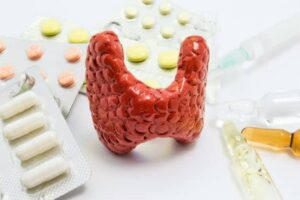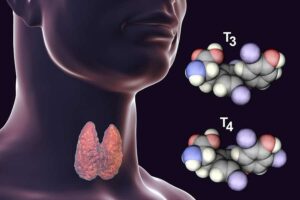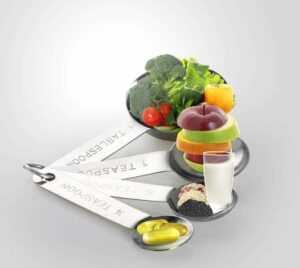Hashimoto Thyroid Disease: How Green Smoothies Helped My Recovery

Hashimoto thyroid disease, also known as Hashimoto’s thyroiditis, and other thyroid health disorders are becoming an epidemic. Right now, there are 200 million diagnosed worldwide with thyroid disease, 20 million of these are Americans. Learn more about thyroid health and the best diet for Hashimoto’s below.
In this article:
- How Patients Suffer from Hashimoto Thyroid Disease
- My Journey Through Hashimoto Thyroid Disease
- Thyroid Tests to Ask For
- Thyroid Health and Nutrition: Is The Autoimmune Protocol the answer?
- Greens as Part of Your Diet for Hashimoto Thyroid Disease
- Why You Need Whole Foods for Thyroid Health
- Hashimoto Diet Recipes Featuring Green Smoothies
Hashimoto Thyroid Disease: Symptoms, Tests, Food for Thyroid Health, and My Journey
How Patients Suffer from Hashimoto Thyroid Disease

A large number of people have Hashimoto's disease and don't even know it.
A patient with Hashimoto’s disease usually goes 6 to 7 years untreated, before an accurate diagnosis is even achieved. The longer the condition is untreated, the more progressed it will become.
According to thyroid.org, 60% of those with thyroid disease don’t even know that they have it! And as the undiagnosed disease progresses, those who have it are unknowingly putting themselves at greater risk for osteoporosis, infertility, and cardiovascular diseases. Men have moderate rates of thyroid disease, but for women, these diagnoses are exploding and levoxothyrine (Synthroid) has become the most prescribed drug in the world.
A typical Hashimoto’s patient may suffer from the following conditions:
- Weight gain
- Hair loss
- Depression
- Mood swings
- Cold hands and feet
- Fatigue
- Muscle aches and joint pain
- Difficulty concentrating
- Memory loss
- Dry skin
- Brittle nails
My Journey Through Hashimoto Thyroid Disease
My own diagnosis, after suffering from most of those Hashimoto thyroid disease symptoms, came 17 years ago, at the age of 33. Until then, for years, when I complained of many of the symptoms above, doctors gave me a T3 or a TSH test, told me I was “fine,” and dismissed my symptoms as being related to having four babies in 7 years.
I have been in complete remission from Hashimoto’s for 17 years. I started with the standard drug prescription. That was the only recommended intervention, and I was sent out the door.
At first, I felt better and was able to finally lose most of the 70 pounds I had gained during the untreated phase, but after a number of months, I started to feel worse. This is very typical of a thyroid patient whose only intervention is a drug prescription.
I discovered that lifestyle and diet changes would be needed, for any true healing. Then, I discovered that bioidentical thyroid would decrease my cancer and overall disease risk, as the bioidentical substances were an exact molecular match to the thyroid hormone my body produces. Bioidenticals are a big improvement on the molecularly altered and/or highly synthetic substances in levothyroxine and other pharmaceutical drugs.
I also discovered that the thyroid doesn’t act alone, in a vacuum. Other glands, organs, and hormones were involved in a turnaround of my health. I needed a full blood-panel workup, and I found that as more people discover the health risks of taking the synthetic drugs (molecularly different than human thyroid, progesterone, estrogen, and testosterone), a growing field of “functional medicine” practitioners could do much more to reverse my progressing autoimmune condition.
Thyroid Tests To Ask For

If you get tested by a regular doctor for thyroid issues, you might pass even though your thyroid is not working the way that it should to keep you healthy.
I spent too many years limited by the “Standard-of-Care” doctors who tested my TSH, declared me “normal” according to a huge range they consider normal, and sent me home. A functional medicine practitioner – often a nurse practitioner who has a master’s degree and can prescribe medications – looks for the root cause and addresses that, rather than simply treating symptoms as the MDs had in the early years of my treatment.
In fact, looking at upstream “precursor” hormones in broader-based blood tests played a significant role in addressing the “big picture” of my health.
Hormones to Ask A Functional Medicine Practitioner to Test, If you Suspect Hormone Issues:
- Pregnenolone
- Vitamin D
- DHEA
- Estrogen
- Progesterone
- Testosterone
- Free T3 and T4 (thyroid hormone)
- Thyroid Stimulating Hormone (TSH)
- Thyroid Antibodies TPO and TSI
Let’s take a look at these in a little more depth, starting with your pituitary gland. This all-important endocrine gland is called the “master gland” because it produces hormones that control the other glands.
One of these, called thyroid stimulating hormone (TSH), does as its name implies. It stimulates the release of hormones from the thyroid gland. The main hormone that the thyroid then produces is T4.
In order for the body to use T4, it must first be converted to T3–also known as the “energy” or “active” hormone which is then absorbed by all the cells in your body when it becomes Free T3 (T3 that has been cleaved from protein).
T4 levels are often tested because most prescriptions for hypothyroidism are made from synthetic T4. Free T4 determines how much is available for your body to use. But, as previously explained, T4 must be converted to T3 and then Free T3, the most active form of thyroid hormone.
Doctors have a tendency to check for TSH, T4, and Free T4 … and leave it at that. But what if your body isn’t converting T4 into T3? Or what if the problem is really an autoimmune disease such as Hashimoto’s? Screening for T3 as well as TPO and TGB antibodies are important tests and steps to an accurate diagnosis.
On top of that, TSH has a tendency to fluctuate and, in all honesty, is not very reliable. It may very well be one of the reasons that so many people are walking around with a thyroid disorder and don’t know it.
The other very important lab test that most doctors disregard is pregnenolone, also known as the ultimate precursor hormone. Your body actually uses this hormone to make your other hormones, such as DHEA, estrogen, progesterone, and testosterone.

If your thyroid hormones are out of wack, it can cause a plethora of issues.
And Vitamin D? Well, this vitamin is actually not a vitamin but a prohormone that is ultimately converted to calcitriol, the active form. There is a strong connection between this nutrient and Hashimoto’s disease. A study conducted in China found that 82 percent of patients who had Hashimoto’s also had low vitamin D levels.
Why don’t most OB/GYNs, GPs, and other medical doctors inside the insurance-code system do the complete set of tests, the “full blood panel?” Very frankly, their training in medical school doesn’t include this level of knowledge.
As more patients demand more holistic, comprehensive, and natural treatment options, more MDs are getting in the game of prescribing bioidenticals. After all, they are subject to market forces, too!
Bioidenticals are not eligible for patents, so drug companies have no interest in them. However, even traditional MDs are being asked by their patients every day for bioidentical versions of hormones, so this kind of treatment is on the rise.
Unfortunately, traditional MDs don’t have the additional 1,000+ clinical hours of training that nurse practitioners who specialize in natural hormone replacement therapy (NHRt) usually do.
In my experience, most MDs do little, if any, extra investigative work when you present with a potential thyroid problem. All they do is the standard minimum blood test, and give you a bioidentical T3 or T4 hormone prescription rather than Synthroid.
That’s simply not good enough. As we’ve indicated, many other upstream and downstream substances, glands, and hormones play a role in getting you on track, so you can beat the depression, weight gain, and other symptoms.
Thyroid Health and Nutrition: Is The Autoimmune Protocol the Answer?
Another common problem in the way thyroid patients are treated is that many of the practitioners, including the “functional” or more holistic ones, can’t take the time necessary to educate their patients about the role of their diet and thyroid health.
So, they often plug the patient into whatever fad diet is ruling, at the time.
The practitioner may prescribe you the Autoimmune Protocol (AIP), which may help identify foods thyroid patients are sometimes reactive to, such as lectins in beans, or oxalates or goitrogens in greens.

Avoiding certain types of food can help a lot with thyroid issues. AIP helps identify which foods to avoid.
Two things about the AIP are of significant concern to me as I continue to study thyroid health, overall health, and trends in functional medicine.
A growing body of evidence documents that, in fact, the “anti-nutrients” may be friends, with supporting roles in your health, rather than foes.
One, the AIP is a temporary way of eating while you heal, but avoiding all legumes (chickpeas, black beans, kidney beans, split peas, and the like) over a lifetime is counter to a massive body of evidence showing these foods to be an important part of the diet of the healthiest people around the world.
Two, the Internet-popularized idea that crucifers and greens (high in two anti-nutrients, goitrogens and oxalates) should be avoided, does not seem to have solid science underpinning it. It appears to be a theory that has been spread mostly on the internet without any tests to back it up.
One of the reasons this theory is problematic is that some under-educated thyroid practitioners assume that an “anti-nutrient” is bad for you, and a growing body of evidence documents that, in fact, the “anti-nutrients” may be friends, with supporting roles in your health, rather than foes.
Greens as Part of Your Diet for Hashimoto Thyroid Disease
Another reason suggesting that the idea that avoiding greens isn’t a good strategy, for most thyroid patients, is that our thyroid-disease-free primate cousins forage for greens all day, every day, and the healthiest populations in the world, for thousands of years, have mostly eaten significant or even massive quantities of greens.
I haven't found any significant or published or controlled-study evidence that greens are anything but highly nourishing and healing to the vast majority of thyroid patients. In fact, there are dozens of micronutrients in virtually all greens that have known therapeutic effects for regulating and balancing hormone function.

Keeping a lot of greens in your diet can help with thyroid issues.
This suggests that to laser in on goitrogens in broccoli and cabbage or oxalates in spinach and kale, and ban them from your diet, is anywhere from unhelpful to tragic, at least as a long-term strategy.
Why You Need Whole Foods for Thyroid Health
My own medical history is nothing more than a “case study,” and my results may not precisely parallel yours. You may have gut problems (common in thyroid patients who have progressed to Stage III or IV), and if so, you may need to limit or eliminate, usually temporarily, some “healthy” classes of foods, such as nightshades (peppers, tomatoes, eggplant), onions and garlic, or legumes, while you heal.
But for over 20 years now, I have eaten a primarily plant-based diet (95% of my diet is from plants, and most days, I eat no animal products), with greens the day-in, day-out highest-quantity food I consume, in a great deal of variety, and served in a number of ways: salads, green smoothies, green juice, and sautéed or steamed greens. Legumes and nightshade vegetables are also a staple of my diet.
My thyroid antibodies are undetectable, making me a Hashimoto’s patient in complete remission for a decade and a half now. If nothing else, this should challenge the assumption that to be well, a thyroid patient must (a) follow the latest fad diet, (b) eliminate healthy categories of foods, (c) skimp on greens, or (d) eat significant amounts of animal protein.
Not only has this diet, which is counter to virtually all the latest “fad diets,” healed my thyroid battered by exposure early in my life by the radiation coming from the Nevada Test Site, but it has led to my being a 51-year old competitive athlete, author of 15 wellness books, and single mom of four, living the life of my dreams. This would not have been possible if I still had the 21 disease states I was diagnosed with 17 years ago, including heart disease, a tumor, mini-strokes, and 4 autoimmune conditions!
For the sake of my long-term health and disease risk, I cannot afford to leave greens, vegetables, all “carbs,” and legumes out of my diet.
After all, the thyroid is a magnet for toxins. Your chemical and radioactive exposures tend to concentrate in this tiny, critically important gland that governs your metabolism. And if you don’t eat and live in ways that nourish it, you’re likely to find yourself in the downward spiral of adding more symptoms and diagnoses to a growing list of miseries.
So, if you don’t have food sensitivities, you may want to consider eating a more inclusive whole-foods diet, rather than following a fad. How to test for food sensitivities? US Biotek and Meridian Valley are the best labs, according to my friend, Alan Christianson, NMD, who has split-tested the efficacy of the lab tests with 22 patients.
In some tests, he sent the same person’s blood in two vials, to two different labs, and in another testing, he sent two vials of the same person’s blood to the same lab but marked as two different people. With the other big lab companies, Dr. Christianson told me, the results for the same person were wildly different, casting doubt on the efficacy of their tests. US Biotek and Meridian Valley are the labs he still trusts after his testing.

A whole foods diet can be a great way to help with thyroid issues.
Be encouraged that healing the gut microbiome damaged from eating a diet high in chemicals and processed foods or use of many synthetic pharmaceuticals and antibiotic can lead to the elimination of food sensitivities, over time. A commitment to a healthy diet and reduction of toxic exposures is required.
Hashimoto Diet Recipes Featuring Green Smoothies
I’m sharing with you two wonderfully thyroid-supportive green smoothie recipes I use often. I like to minimize the fruit and maximize greens, sprouted flax, and superfoods. But if green smoothies are new for you, and you’re weaning off “Standard American Diet” tastes, feel free to add a bit more fruit to these recipes, at first. Throw in something you have on hand, or omit something you don’t have, because the nice thing about green smoothies is, you can’t mess them up! If they’re too thick, add water, or aloe vera juice.
Hashimoto Thyroid Love Green Smoothie
- 2 cups water
- ½ to 1 cup organic aloe vera juice
- 2 tbsp. organic sprouted flax
- 3 large handfuls spinach, kale, and/or collards
Blend well. Then, add:
- 1 cup organic frozen, mixed berries
- 1 small banana
Blend well and drink immediately. Save the rest in pint jars and keep in the fridge! Yield: 6+ cups, or 3 pints.
Hormone-Support Green Smoothie
- 1 1/2 cup organic almond milk
- 1 1/2 cup water
- an organic celery stalk
- a cup of green or purple cabbage
- 2 handfuls organic spring mix
- 1 tsp turmeric
- 1/2 tsp ginger (or ½” fresh ginger)
- 1 cup chopped pineapple
- 1 cup frozen blueberries
Blend well and drink immediately. Save the rest in pint jars and keep in the fridge! Yield: 6+ cups, or 3 pints.
After learning how green smoothies can help you recover from Hashimoto thyroid disease, you may want to check out this video from our channel on how to make a green smoothie.
I, Robyn Openshaw, a Hashimoto thyroid disease survivor in complete remission, and author of bestsellers including The Green Smoothies Diet, Vibe, and 12 Steps to Whole Foods, have made you a four-video masterclass on principles I discovered. I healed not only thyroid disease but 20 other diagnoses with evidence-based nutrition principles rather than fad diets. Learn about thyroid detox and organs of elimination by watching my video. You can watch it for free here.
Did we miss anything on our discussion about Hashimoto thyroid disease? Tell us in the comments section below!
Read next: Thyroid: What You Need To Know

Disclosure: This post may contain affiliate links that help support the GSG mission without costing you extra. I recommend only companies and products that I use myself.
Posted in: 12 Steps To Whole Food, Detox, Green Smoothies, Health Concerns, Natural Remedies, Recipes, Whole Food














